How to avoid thinning hair
If you want to keep your luscious locks full and thick you’ll need to keep up with healthy hair habits and avoid the bad habits that ruin your hair. Dermatologists and stylists share what you’re doing wrong and how to fix the following everyday habits that are thinning your hair.
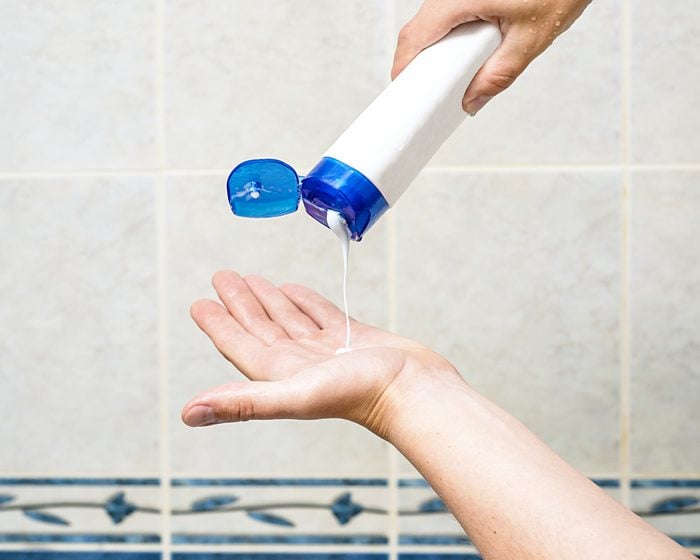
Bad habit: Not shampooing frequently enough
“Shampooing is so important to the health of the scalp and hair. Your scalp is skin, and the way to keep the scalp healthy is to shampoo frequently,” says Anabel Kingsley, consultant trichologist for the Philip Kingsley clinics, who explains that regular shampooing ensures that hair grows at its best rate and helps avoid thinning hair. How often should you wash?
“That varies a bit from person to person, based on how oily your scalp is,” says Melissa Piliang, MD, a dermatologist at the Cleveland Clinic. “But most people should wash their hair at least every other day. If you don’t, things like oils and pollutants can build up on the scalp, leading to inflammation and dandruff (seborrheic dermatitis).” The inflammation can disturb hair growth, and dandruff can lead to itching, which leads to scratching . . . and breakage. Make sure you know how to properly wash your hair too.
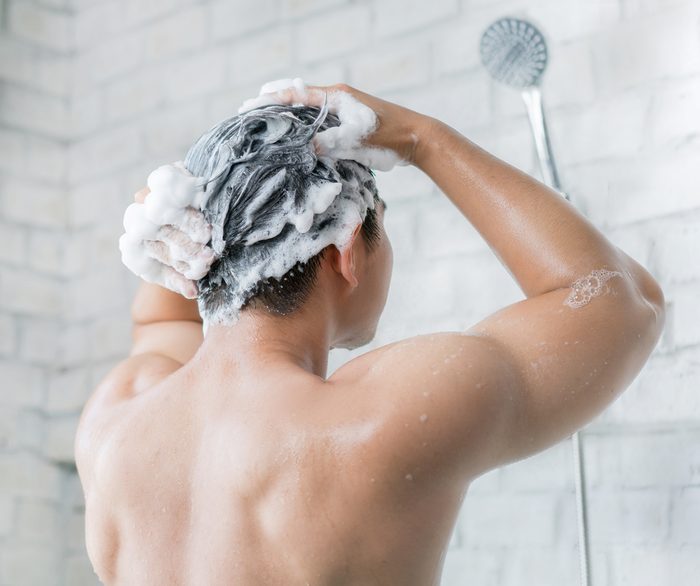
Bad habit: Shampooing too frequently
This can be a concern for people with dry or brittle hair. “For them, frequent shampooing can lead to breakage, especially if they use a drying shampoo,” says Dr. Piliang. African Americans may need to wash their hair less frequently because it tends to be more fragile. For anyone with dry, brittle, or fragile hair, a moisturizing shampoo and a good conditioner can help prevent breakage that can lead to thinning hair. Here’s how often you should wash your hair according to your hair type.
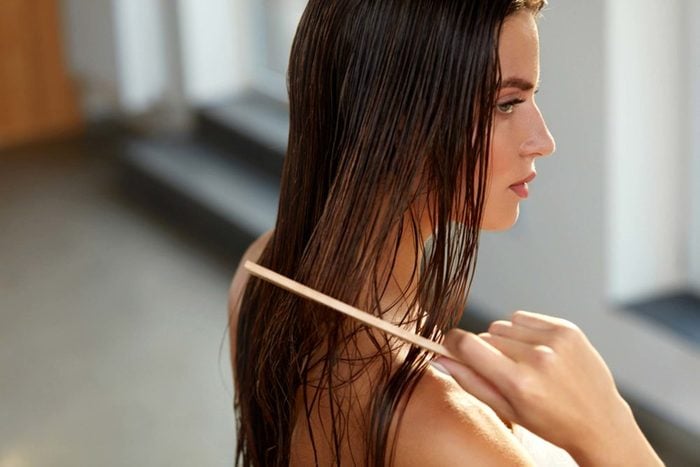
Bad habit: Treating your tresses too roughly
“Everything you do to your hair, do it gently,” recommends Nunzio Saviano, owner and stylist at the Nunzio Saviano Salon in New York City. “Don’t aggressively shampoo. Condition your hair gently. And use a wide-tooth comb for detangling. The less you pull on your hair, the better.”
And if you’ve gotten into the habit of brushing your hair vigorously in the morning and at night—don’t: “A lot of people find it satisfying to brush their hair, and think that 100 strokes a day is good for it. It’s not!” says Kingsley. She recommends that her clients brush their hair only when it needs it, and detangle hair carefully using a detangling spray and starting at the bottom “rather than starting at the top and ripping down at the hair.”

Bad habit: Not eating for (hair) health
“The best diet for your hair is the same one that’s best for your heart, brain, and longevity—the Mediterranean diet, with lean protein, nuts, fruits and vegetables, whole grains, and healthy fats,” says Dr. Piliang. Protein is especially important: Your hair is made of protein, and eating enough helps gives hair its strength and structure.
Says Kingsley, “If you aren’t eating correctly, no matter what products you use on your hair, it simply won’t grow to its best ability.” Being low in iron, vitamin D, zinc (a rare deficiency), or any of these vitamins can lead to thinning hair.
“Often, people are treated for genetic hair loss when it’s actually an iron deficiency that’s responsible,” says Evan A. Rieder, MD, assistant professor in the Ronald O. Perelman Department of Dermatology at NYU Langone Health. Women with heavy periods, those following fad diets or other restrictive eating plans, vegetarians, and vegans should all be careful to get enough iron. And while it’s always best to get nutrients from healthy, fresh food, when that’s not possible, dietary supplements can be helpful.
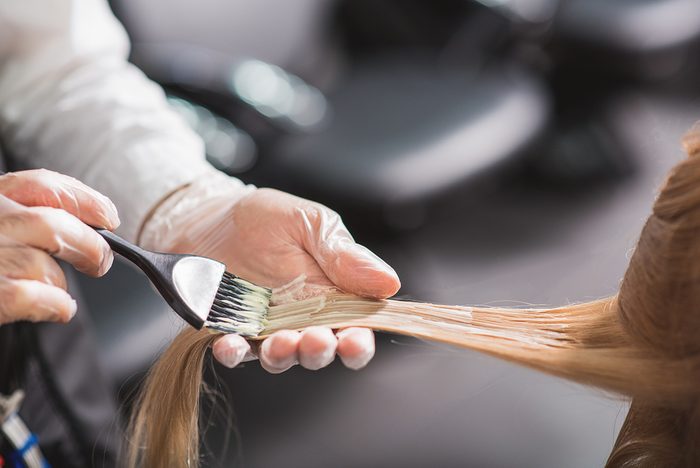
Bad habit: Overbleaching
While adding color to hair actually plumps up the fiber and makes it more full, bleaching hair isn’t so kind. “Bleaching color from hair damages the cuticle,” explains Dr. Piliang. “And that causes the hair fiber to become thinner and more prone to breakage.” Ask your hairdresser whether you can achieve a similar look with a high-lift hair color rather than bleach. Or at least reduce the frequency of bleaching to minimize thinning hair.
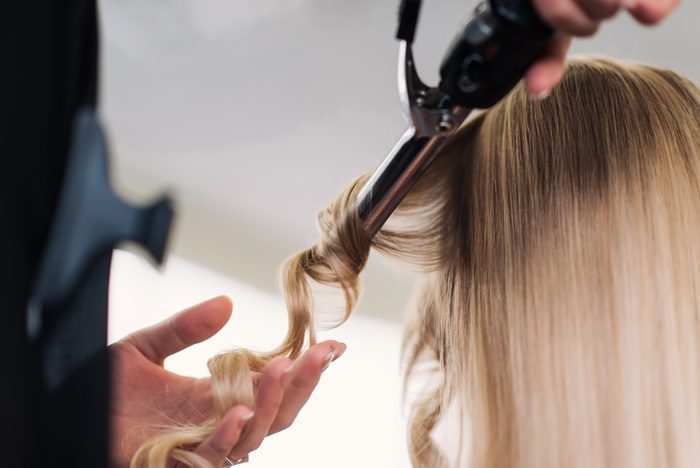
Bad habit: Turning the heat up too high
“Styling tools like hot rollers, and curling and flat irons, can be especially harsh on the hair, causing breakage and making the scalp weak. And if you’re also using a hairdryer daily, avoid the hottest setting as much as possible,” advises Todor Todorov, longtime stylist for Bumble & Bumble Salons.
Adds Dr. Piliang, “All of these things weaken the hair shaft, the fiber. They can damage the cuticle on the outer layer of the hair, especially if you’re using high heat or using things like a straightening iron every day.”
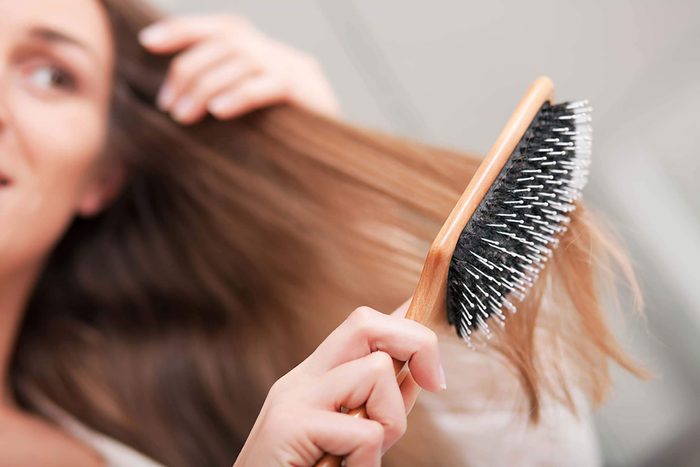
Bad habit: Using the wrong brush
“These are tools you use on your hair every day, and the wrong brush can do a lot of damage, cause a lot of breakage,” says Kingsley. She explains that popular boar-bristle brushes are actually the least hair-friendly option, even though people like them for styling because they give the best traction. Need convincing? Kingsley says that if you run a boar-bristle brush against your skin, you’ll feel how scratchy it is. And if you brush a wool sweater 50 times with one, you’ll see that sweater become frayed.
So skip expensive boar-bristle brushes and skip metal brushes, too, since they can get very hot during heat styling. Instead, Kingsley recommends a brush with rounded plastic prongs, preferably with a vented plastic base so you don’t get a lot of concentrated heat when you style your hair. Plastic brushes tend to be less expensive than metal or boar bristle, and they’re the most hair-friendly option. A win-win!
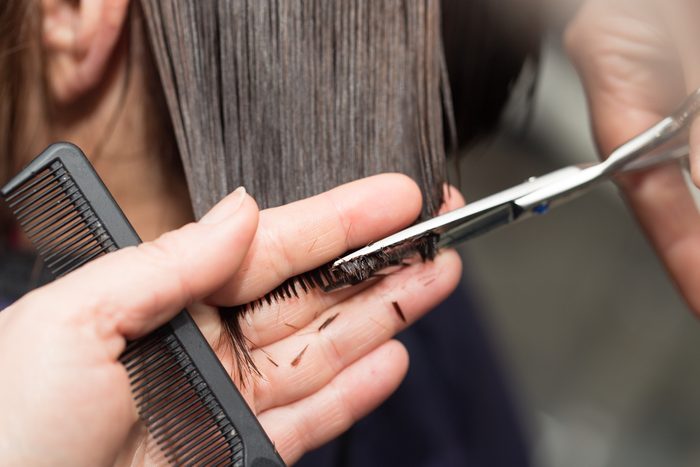
Bad habit: Not getting frequent trims
Often, people who want to grow their hair longer stop getting regular trims to speed up the process. But that’s not the best strategy for thick, healthy hair growth. “When people stop getting haircuts, it can lead to damage and breakage,” explains Dr. Piliang. “It’s better to go every eight weeks or so for a trim.” Even just a minimal haircut of a quarter inch or so—what stylists call a dusting—can help your hair grow healthier and avoid thinning hair.

Bad habit: Letting stress get out of control
“The things we associate with a less healthy lifestyle are harmful to hair, and one of those factors is stress,” says Dr. Piliang. “We know that people who have a more stressful life have thinner hair.” Stress raises the levels of the hormone cortisol, which can lead to hair shedding. So it’s important to manage stress with exercise, yoga, meditation, or other activities.
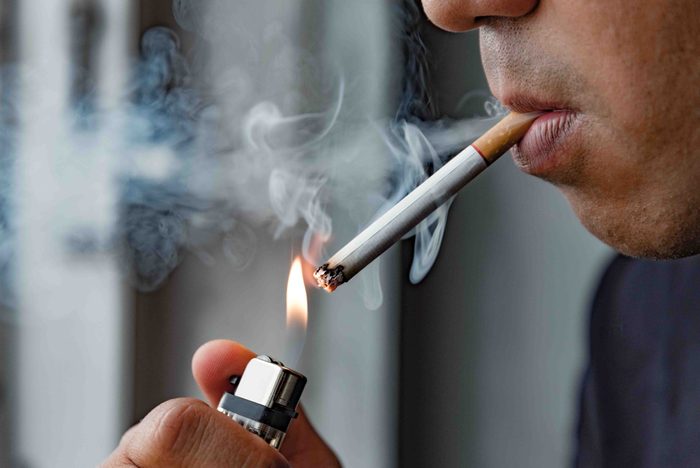
Bad habit: Smoking
Is smoking good for anything? Nope—and definitely not for your hair. “Smoking can cause thinning hair by reducing blood circulation to the scalp,” says Dr. Rieder, who explains that reduced blood flow can inhibit the growth of hair follicles. “Cigarette smoke can also lead to oxidative stress and free-radical development, which may directly inhibit cellular activities necessary for hair growth,” he says. Hair may recover when someone quits, depending on how long that person had been smoking, and how much damage was done to the circulatory system.
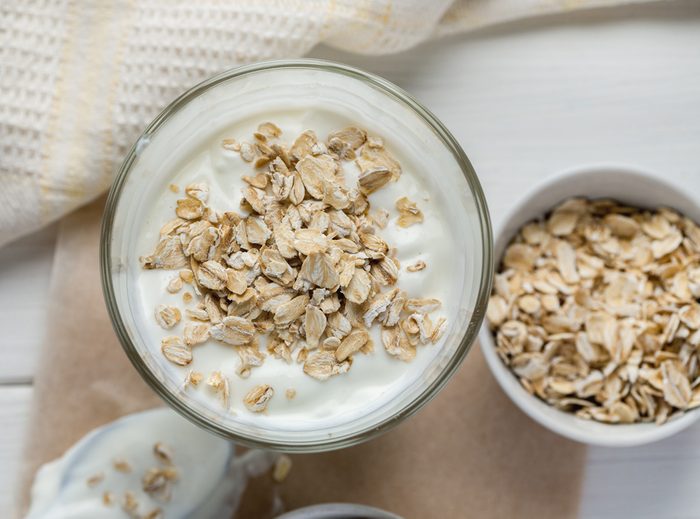
Bad habit: Skipping breakfast
Breakfast may not be the most important meal of the day anymore, but Kingsley says it’s good for hair. “So many people say their diet is great,” she says, “but then they admit that they don’t have time in the morning, and rush out the door without breakfast.” She explains that everything you eat at breakfast goes to fuel the body’s essential systems. Hair isn’t considered an essential system—meaning that keeping the scalp fueled isn’t an issue of life or death—so hair only receives nutrients once the major organs have been fed. Eating breakfast fuels the body’s life-giving functions and helps keep hair soft too.
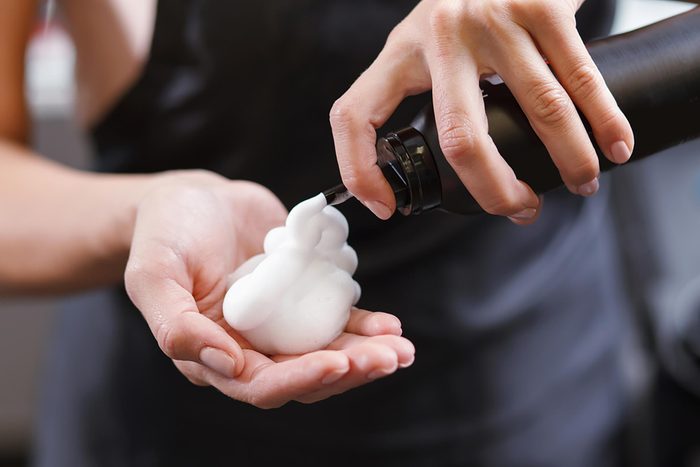
Bad habit: Using the wrong styling products
They’re supposed to make your hair look good, but some styling products can have the opposite effect when you use them for a long period of time. “Some straighteners and relaxers can scar the hair follicle and cause hair loss,” Dr. Rieder explains. And products like hair spray or gel that claim to hold hair in place all day usually contain alcohol, which can make hair dry and brittle. The residue left on hair from these products can make hair break or fall out when it’s combed or brushed. Instead, look for natural alternatives that are far gentler on hair but will still help keep your style in place.
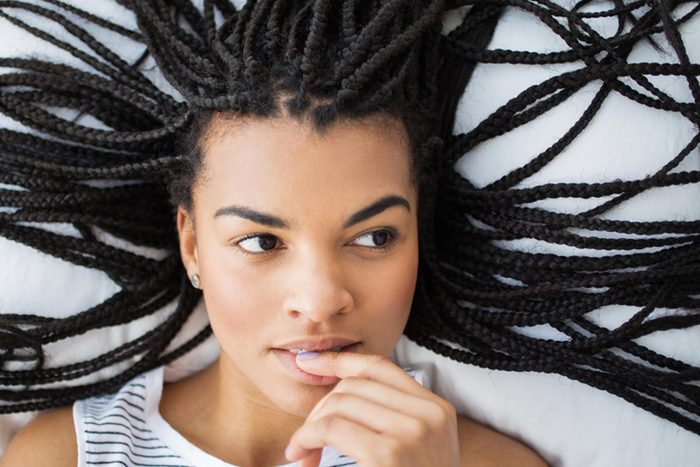
Bad habit: Pulling your hair tight
Cornrows, bun, braids, and ponytails may be adorable, but all of them can lead to thinning hair and hair loss over time, says Todorov. The constant tension can damage the hair follicle, leading to a condition called traction alopecia. “We’ll see thinning and scarring at the hairline, specifically in people who’ve worn tight braids in their hair from an early age,” says Dr. Rieder. Even if you only tie your hair back when you work out, make sure you use a hair-friendly hair tie or clip—or, even better, a soft scrunchy (if you can handle the teasing). (Don’t ignore these 10 scalp conditions.)
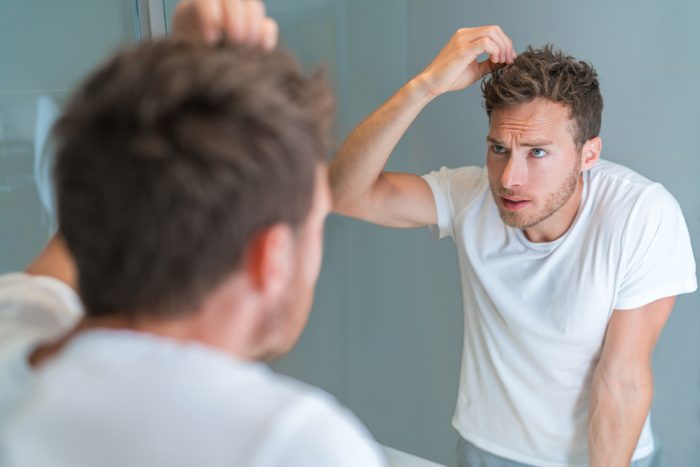
Bad habit: Pulling out grays
There it is, staring at you in the mirror: a gray hair, or maybe a few. You’re not ready to start coloring your hair, so you do the easiest thing you can—yank it out. The problem is, you’re not really dealing with the gray that way . . . and you might be making your hair thinner, too. “Anytime you remove a hair from the root, you could potentially damage the hair bulb and prevent the hair from growing back properly,” says Dr. Rieder. Repeatedly damaging the follicle can make the hair that grows back thinner. There are better ways to deal with gray hairs than pulling them out. “Cover them up instead,” Dr. Piliang urges. “If you only have a few grays, get a cover-up wand.”
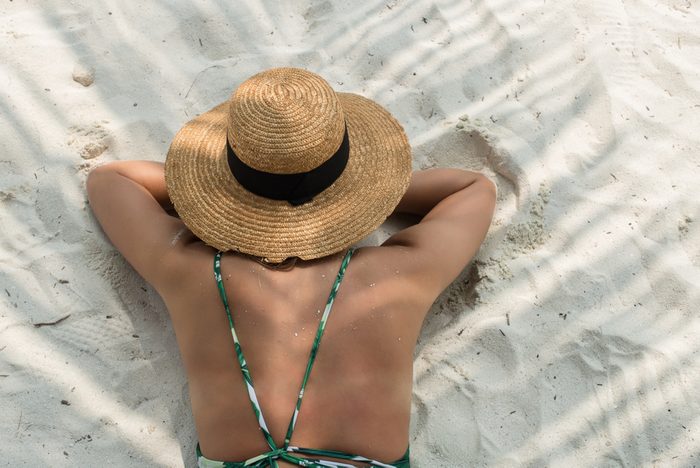
Bad habit: Not protecting your hair from the sun
The sun is not your hair’s friend. “It can damage the cuticle and the hair fiber, and make hair more prone to breaking,” says Dr. Piliang. She recommends that her patients use hair sunscreens or hair products with SPF. “Or you can just wear a hat,” she says.
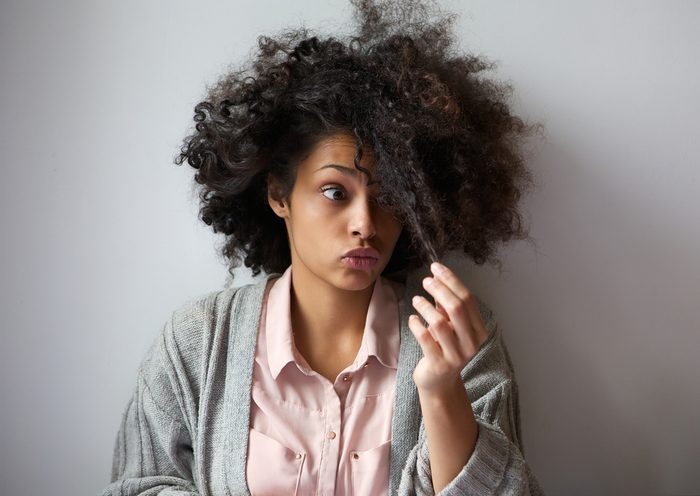
Bad habit: Playing with your hair
We’ve all noticed people meditatively twirling their hair around their fingers, absent-mindedly scratching their head, or pulling hair as a nervous habit. “Unfortunately, compulsively twisting, rubbing, or pulling your hair can contribute to hair loss over time,” Todorov says. There’s usually no permanent hair loss from most of these habits, but it’s important for people to be aware of them.
“Some people may start just by pulling or twirling their hair, but then get to a point where they’re actually pulling hairs out of their head to relieve tension—a condition called trichotillomania,” Dr. Rieder explains. Even if you never get to that point, just twirling your hair can lead to breakage. Find out what your compulsive habits—like hair-twirling and nail-biting—really mean.
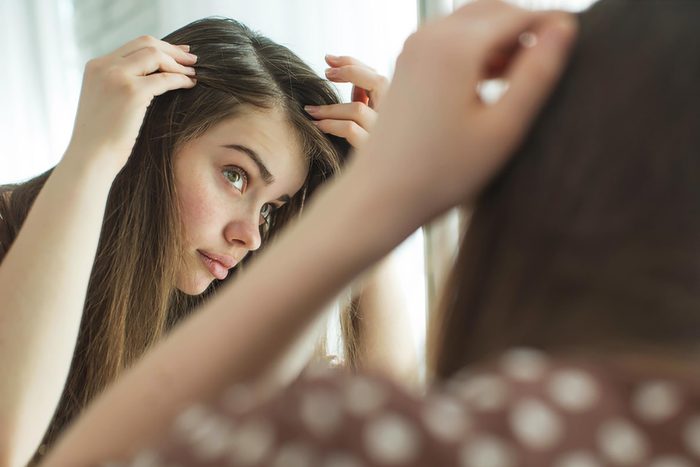
Bad habit: Ignoring hair changes
If you notice that your hair seems thinner, don’t assume it’s a natural part of aging. “One mistake a lot of women make is that they try to ignore when their hair starts thinning,” says Saviano. “They don’t go to a doctor. And they keep doing the same thing.” You may just need to change your routine—be gentler, eat better, or stop styling your hair too roughly. Or you may need to see about more aggressive medical treatment. But you will need to take action. “When hair is shedding, it’s because your body is telling you something,” Saviano says. Check out 8 things your hair may be trying to tell you about your health.
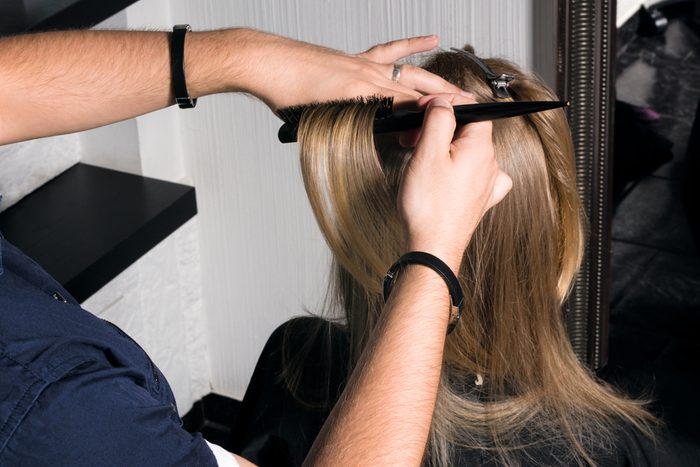
Bad habit: Overcompensating for thinning hair
Almost as bad as ignoring hair changes is trying to compensate for them in a way that can actually make the problem worse, says Saviano: “When women are used to having a lot of body in their hair and they notice it’s starting to seem thinner, often they’ll go to extreme measures to get the body back.” He explains that many of the things that can temporarily make hair seem thicker, like teasing, can be extremely damaging. “Even worse are products that require you to pull the hair from the roots to get a good set,” he says.
Also, once people are worried about thinning hair, many of them start to constantly check it to see what’s happening. “Don’t keep running your hands through your hair to see how many strands are coming out,” urges Kingsley. “That causes even more stress, which makes the hair loss worse. Instead, try to get to the root—pun intended—of the problem to find out why your hair is thinning in the first place.” Next, check out these 30 tips for healthier hair.